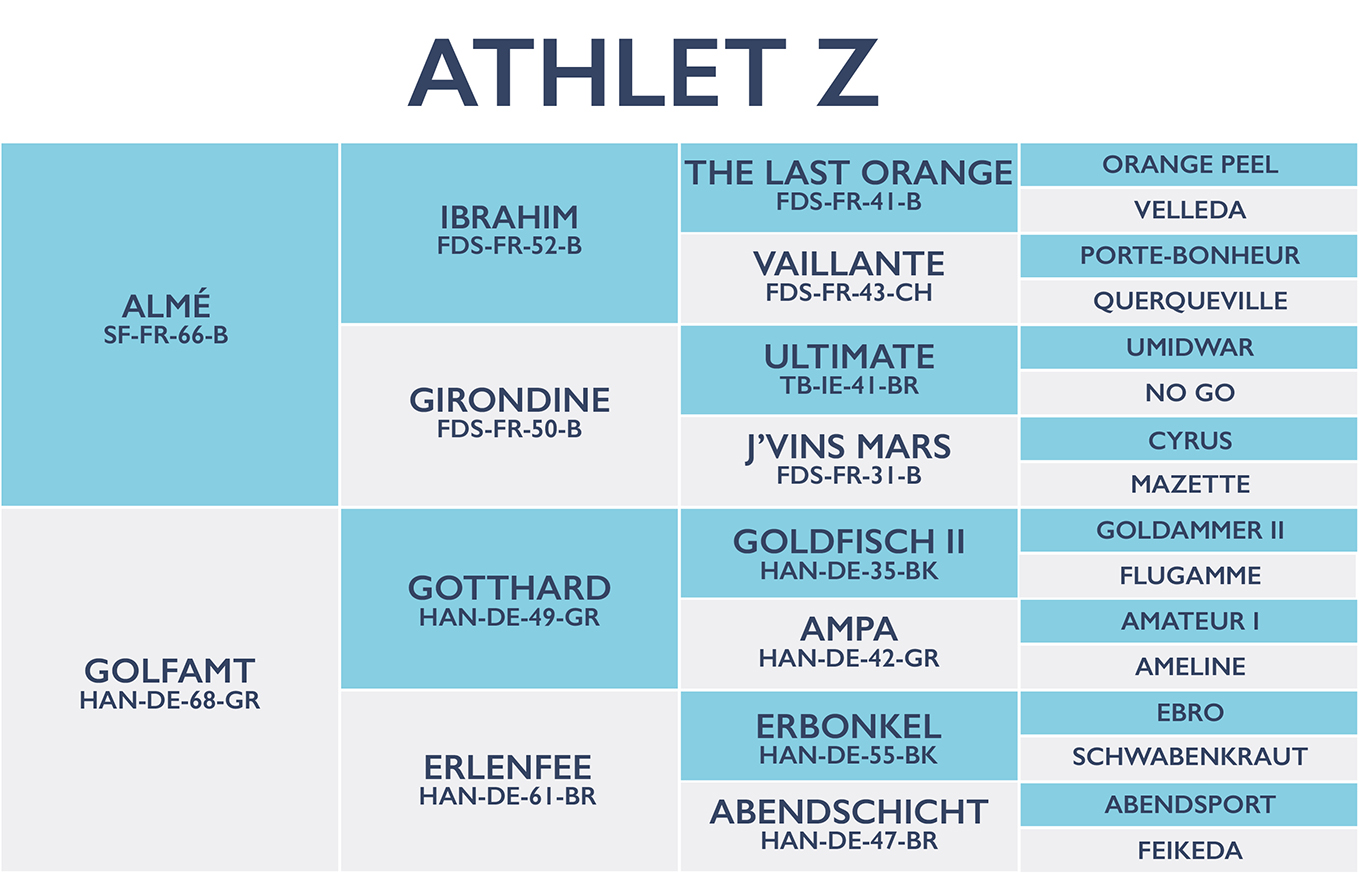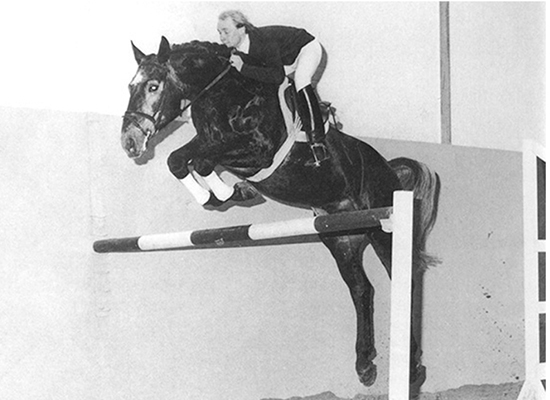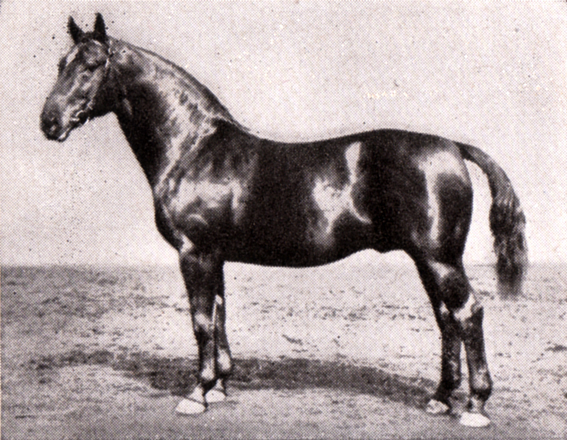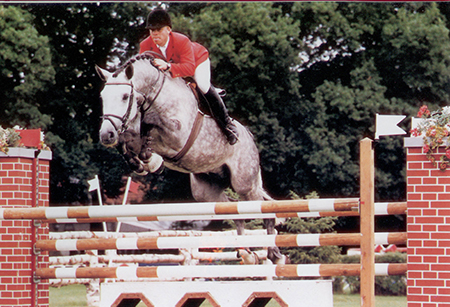1979 – 2005, 168 cms Grey
Breeder – L. Melchior, Zangershide
Stood at: 1982 – Elmshorn; 1983 – Did not stand; 1984-89 – Wöhden, 1990-95 – Marne; 1996-2003 – Zangersheide; 2004 – Klein Offenseth.
In the early 1980s, Holsteiner breeders had heard of Almé and were looking for a way to get his blood into their program, once again, it was Maas J. Hell, who found a way.
The late Maas J. Hell was celebrated as the visionary who brought ‘Corde’ (Cor de la Bryère) to Holstein, and also for vigorously promoting the influx of Thoroughbred blood in the 60’s – a development that may well have saved the Holsteiner from extinction.
He became managing director at Elmshorn in 1971, a time when the German breeding scene was at a low. Only 1200 mares were registered with the Holsteiner Verband.
When Maas J. Hell started his job, the increasing number of riders in Germany meant more horses were needed, and being a true marketing expert Maas J.Hell set about meeting the new demands. Under his direction, the Holsteiner stallion licensing, the show evening and the auction at Neumünster achieved a world-wide fame.
Maas J. Hell not only started the marketing of Holsteiner horses, he re-organised, with great success, the stable of competition horses at Elmshorn. He found horses for the talented Herbert Blöcker, a long term employee of the Verband, who won the individual silver medal on Albrant at the European Eventing Championships at Kiev as a member of the gold medal winning team, the pair were members of the silver medal winning team at the Montreal Olympics. He discovered Corlandus who won a World Cup Dressage Final with Margit Otto-Crépin, and Caletto I ridden by Dr. Michael Rüping.
In his last years as the director of the Holstein Verband, Hell was at the same time he was building up his own private stallion station, which apparently caused a little heartburn at the time.
As might be expected, his private stud was a huge success. Maas J. Hell had his greatest success with Athlet Z, by Almé, Acord II by Ahorn Z, and Cantus by Caletto I.
In 1997 Maas J. Hell died in the age of 63.
After Hell’s death, Thomas Mohr took over the direction of the Stud. Born in 1962 Thomas Mohr got his first pony when he was six years old. His very successful riding career at horse shows started when he was 12 years old. After finishing school he began with his education to become a professional rider.
After having finished his apprenticeship he started work with the Holsteiner Verband, where he met Mass J. Hell, at that time manager at Elmshorn. They immediately got on very well and a very strong friendship based on confidence and respect started. One year later Maas J Hell resigned as managing director at Elmshorn and Thomas Mohr followed him to his private stable at Klein Offenseth. Maas J. Hell started to build up a small but very exclusive showing and breeding yard.
For all the Holstein breeders are considered a conservative bunch, they have been remarkably creative with their breeding program over the last 40 years of the twentieth century. The 1960’s saw the arrival of the great Thoroughbred sires, like Ladykiller who arrived in 1965. The great Selle Français, Cor de la Bryère arrived five years later in 1970. Then at the beginning of the 80’s Maas J Hell reached for new French blood, but this time the horse, Athlet Z, came with a Hanoverian brand on its backside, courtesy of Leon Melchior’s marriage of convenience with the Hanoverian Verband.
In truth Athlet Z’s bloodlines were a heady continental cocktail. His sire Almé was one of the treasures of French breeding, however on his dam’s side, Athlet Z descends from that pillar of Hanoverian breeding, Gotthard, and on the dam line, to an even earlier pillar – Feiner Kerl.
According to Ludwig Christmann in his celebrated – and much studied – paper, The Bloodlines of the Hanoverian:
“The F-line goes back to Zemeboq, a Thoroughbred son who came from Pomerania and stood in the mid 1800’s. The line really began with his great-grandson Flingarth. who stood in the Verden area, 1909-1912, producing about 14 licensed sons. His best son was Fling, (1913-22), and all existing F-line horses go back to Fling. The line was separated into the ‘F’ and ‘W’ lines according to the two Fling sons Feiner Kerl and Flavius: as of 1989, all stallions licensed in that year and going back to Feiner KerI belong to the F-line; all going back to Flavius form the W-line.”
“Feiner Kerl stood in Altenbrugge, and when he died the breeders put up a memorial to him because in his time (1922-43) he had the biggest influence on the Hanoverian breed, producing 114 licensed sons. Going back to Feiner Kerl is the very famous stallion Ferdinand. In his time (1944-67) Ferdinand was perhaps the most famous producer of jumping horses in the world.”
Feiner Kerl, a real foundation sire…
Athlet Z confirms the view that a poor stallion performance test does not necessarily prevent a horse becoming a great stallion. You only have to look at the stallions, Grannus, Capitol I and Grandeur, for further proof of this.
The number of points required in Holstein in those days to pass the performance test was 70. After Athlet Z’s first covering year in Elmshorn, he took part in the Adelheidsdorf stallion performance test, but failed with the score of 66 points (his owner Maas J. Hell was in the final year of his position of manager of the Holstein Verband at that time). This resulted in him not being utilized for breeding in 1983.
Still Hell was following his, at the time, quite radical policy of letting the stallion attract mares in the competition arena, and Athlet Z showed promise showjumping with Thomas Mohr.
He fronted for a second stallion performance test that same autumn. This time, Athlet Z just barely managed to pass the test, which was held in Medingen, with the minimum score of 70 points. The Holstein breeders however put their trust in the enormous jumping potential of this grey stallion and strongly utilized him for breeding. Athlet Z repaid their faith, by producing performance horses with exceptional frequency. His first crop produced the world-class horse Athletico with Ludger Beerbaum and many more were to follow, including Argentinus (Otto Becker), Athlet (Willi Melliger), Amadeus (Lars Nieberg), Avion (Werner Peters & Ludger Beerbaum), Andolph (Claudia Vasall), Montreal (Wim Schröder) and Valeska (Dr. Michael Rüping).
Athlet Z, like so many Almé progeny, was highly intelligent. He was the darling of his owner Maas J. Hell, who trained him to do tricks, like retrieving canisters and whips. He spent the autumn of his life in Belgium but returned home to Holstein in 2004, where he passed away in his 26th year at the beginning of 2005.
But according to Thomas Mohr, the Athlets were horses for the professional: “There were many sport horses by Athlet, they were not always easy to ride, they had a strong character. The horses by Ahorn were easy to ride.”
The stallion, Acobat I
Athlet Z was a prolific sire of stallion sons, including: Abdulkarim, Acobat I, Acobat II, Acobat III, Adelfos, Aldan, Aletto. Alido, Arturo, Athletic Lord, Athletico, Atlantus Z, Attikos, Avero, Azzaro Z and Bavaria Blue.




